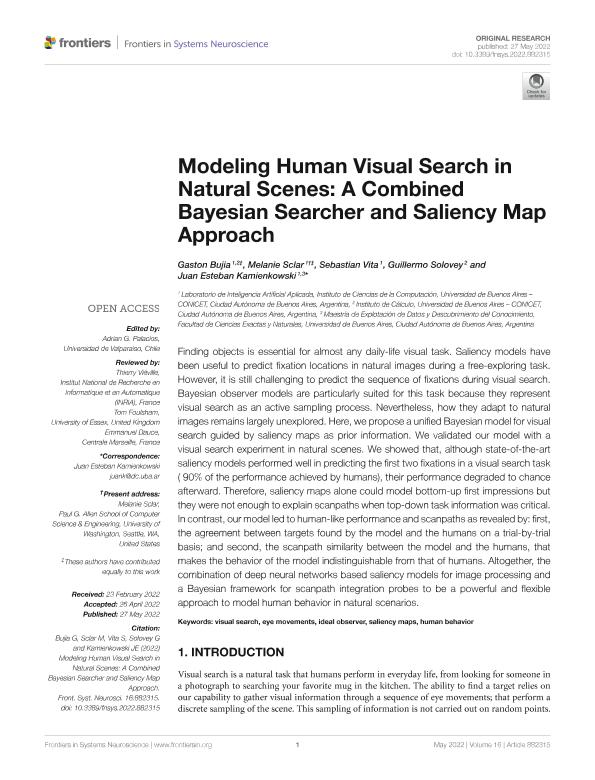Artículo
Modeling Human Visual Search in Natural Scenes: A Combined Bayesian Searcher and Saliency Map Approach
Bujía, Gastón Elián ; Sclar, Melanie; Vita, Sebastián Alberto; Solovey, Guillermo
; Sclar, Melanie; Vita, Sebastián Alberto; Solovey, Guillermo ; Kamienkowski, Juan Esteban
; Kamienkowski, Juan Esteban
 ; Sclar, Melanie; Vita, Sebastián Alberto; Solovey, Guillermo
; Sclar, Melanie; Vita, Sebastián Alberto; Solovey, Guillermo ; Kamienkowski, Juan Esteban
; Kamienkowski, Juan Esteban
Fecha de publicación:
05/2022
Editorial:
Frontiers Media
Revista:
Frontiers in Systems Neuroscience
e-ISSN:
1662-5137
Idioma:
Inglés
Tipo de recurso:
Artículo publicado
Clasificación temática:
Resumen
Finding objects is essential for almost any daily-life visual task. Saliency models have been useful to predict fixation locations in natural images during a free-exploring task. However, it is still challenging to predict the sequence of fixations during visual search. Bayesian observer models are particularly suited for this task because they represent visual search as an active sampling process. Nevertheless, how they adapt to natural images remains largely unexplored. Here, we propose a unified Bayesian model for visual search guided by saliency maps as prior information. We validated our model with a visual search experiment in natural scenes. We showed that, although state-of-the-art saliency models performed well in predicting the first two fixations in a visual search task (90% of the performance achieved by humans), their performance degraded to chance afterward. Therefore, saliency maps alone could model bottom-up first impressions but they were not enough to explain scanpaths when top-down task information was critical. In contrast, our model led to human-like performance and scanpaths as revealed by: first, the agreement between targets found by the model and the humans on a trial-by-trial basis; and second, the scanpath similarity between the model and the humans, that makes the behavior of the model indistinguishable from that of humans. Altogether, the combination of deep neural networks based saliency models for image processing and a Bayesian framework for scanpath integration probes to be a powerful and flexible approach to model human behavior in natural scenarios.
Palabras clave:
EYE MOVEMENTS
,
HUMAN BEHAVIOR
,
IDEAL OBSERVER
,
SALIENCY MAPS
,
VISUAL SEARCH
Archivos asociados
Licencia
Identificadores
Colecciones
Articulos (IC)
Articulos de INSTITUTO DE CALCULO
Articulos de INSTITUTO DE CALCULO
Articulos(ICC)
Articulos de INSTITUTO DE INVESTIGACION EN CIENCIAS DE LA COMPUTACION
Articulos de INSTITUTO DE INVESTIGACION EN CIENCIAS DE LA COMPUTACION
Citación
Bujía, Gastón Elián; Sclar, Melanie; Vita, Sebastián Alberto; Solovey, Guillermo; Kamienkowski, Juan Esteban; Modeling Human Visual Search in Natural Scenes: A Combined Bayesian Searcher and Saliency Map Approach; Frontiers Media; Frontiers in Systems Neuroscience; 16; 882315; 5-2022; 1-14
Compartir
Altmétricas



